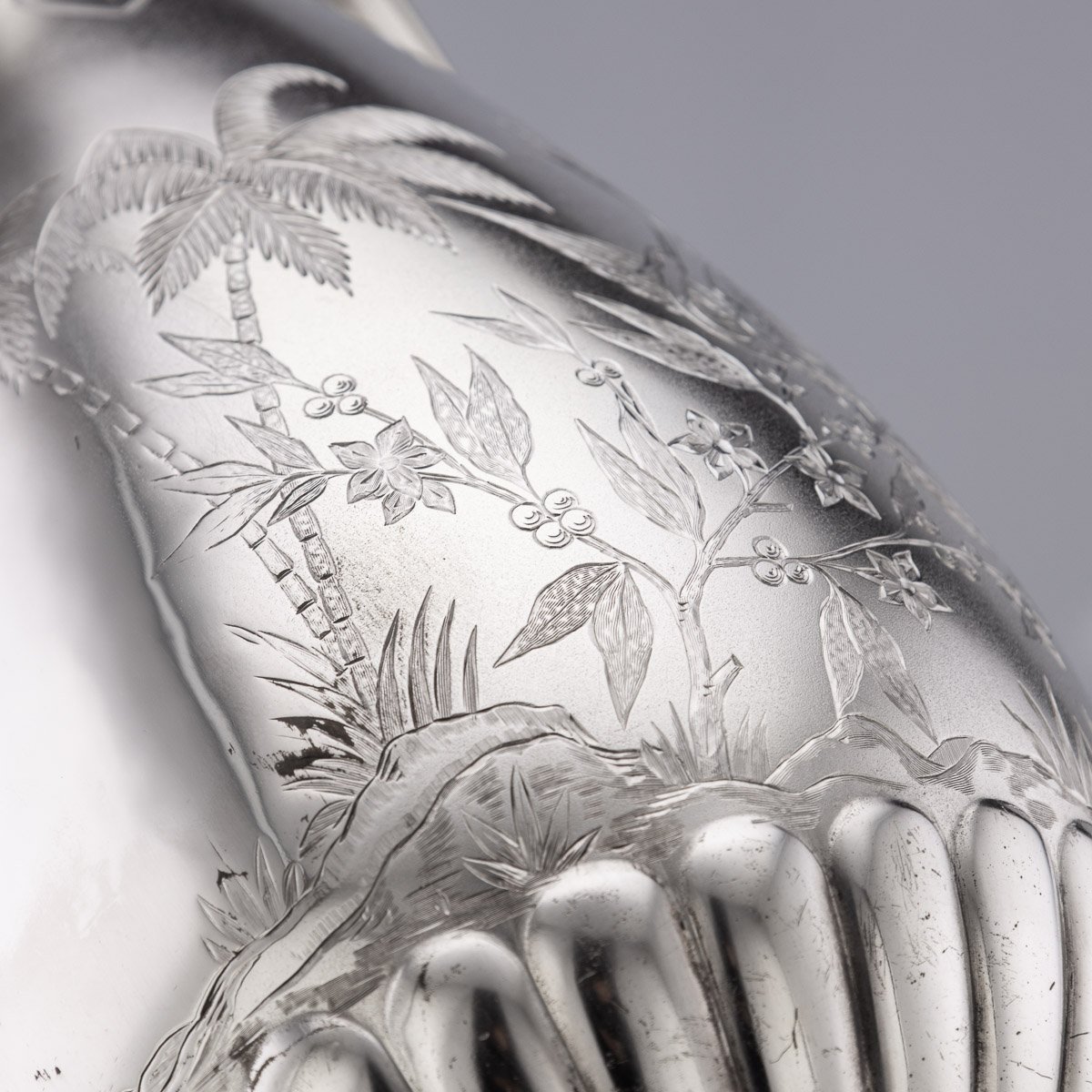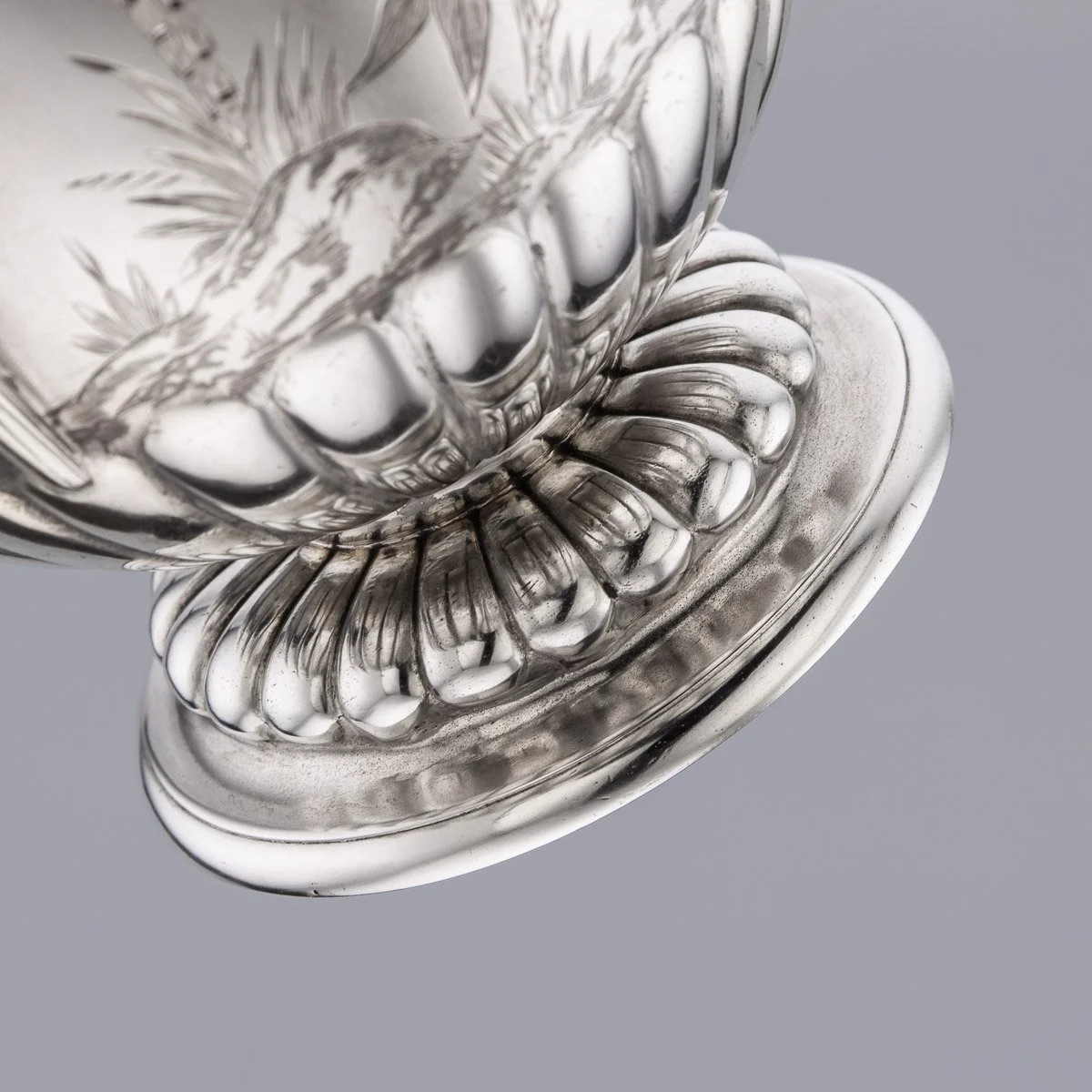ANTIQUE 19thC VICTORIAN AESTHETIC MOVEMENT SOLID SILVER WINE JUG c.1878
19th Century Victorian Aesthetic movement silver lidded wine jug, the bulbous body beautifully hand engraved with chinoiserie scenes, bamboo trees and exotic birds, the neck decorated with leaf decoration, body mounted with a shaped handle and a hinged lid.
Hallmarked English silver (925 standard), Birmingham, year 1878 (D), Maker FE (Elkington & Co).
Reference Number: A7990
19th Century Victorian Aesthetic movement silver lidded wine jug, the bulbous body beautifully hand engraved with chinoiserie scenes, bamboo trees and exotic birds, the neck decorated with leaf decoration, body mounted with a shaped handle and a hinged lid.
Hallmarked English silver (925 standard), Birmingham, year 1878 (D), Maker FE (Elkington & Co).
Reference Number: A7990
19th Century Victorian Aesthetic movement silver lidded wine jug, the bulbous body beautifully hand engraved with chinoiserie scenes, bamboo trees and exotic birds, the neck decorated with leaf decoration, body mounted with a shaped handle and a hinged lid.
Hallmarked English silver (925 standard), Birmingham, year 1878 (D), Maker FE (Elkington & Co).
Reference Number: A7990
DESCRIPTION
Antique 19th Century Victorian Aesthetic movement solid silver lidded wine jug, the bulbous body beautifully hand engraved with chinoiserie scenes, bamboo trees and exotic birds, the neck decorated with leaf decoration, body mounted with a shaped handle and a hinged lid. Hallmarked English silver (925 standard), Birmingham, year 1878 (D), Maker FE (Elkington & Co), with later import marks.
The firm, founded in 1815, became very popular for pioneering the electroplating and gilding techniques.
It was established in Birmingham by George Richards Elkington’s uncle. George Richards took over the business after his uncle’s death together with his cousin Henry Elkington. A third partner, Josiah Mason who manufactured pens joined the firm from 1842 to 1861, when he left. After George Richards death in 1865 his sons successfully managed the business, which operated independently as Elkington & Co. until 1963.
In 1830s Elkington & Co. were awarded the first patents for mastering the electroplating technique which consists in applying a thin coat of silver to a different metal using electricity. The process was then brought to perfection in 1840, thanks to the recent chemical discoveries of John Wright, a Birmingham surgeon. The Elkingtons quickly understood the potential of the new technology and acquired rights and patents of this improvement.
The firm produced a great number of electrotypes, perfect electroplated reproductions of metal objects. Henry Cole, first director of the South Kensington Museum (today Victoria & Albert Museum) grasped the educational potential of the new technique, and agreed with Elkington to take moulds of historic objects in museums in England and around the world. By 1920 the V&A held about 1000 electrotypes, later sold to the public and other museums.
However the production of the firm was very diversified. Electroplated tablewares became extremely popular in the Victorian market and the company kept growing, counting 1000 employees in 1880. They received important commissions and supplied tableware and cutlery for the Titanic and the Royal Yacht Britannia’s banqueting room.
For the fine quality, accuracy artistic design typical of their production the company was awarded the Royal Warrant by Queen Victoria and held it for six consecutive reigns.
CONDITION
In Great Condition - No Damage.
SIZE
Height: 34cm
Width: 14 x 12cm
Weight: 770g























